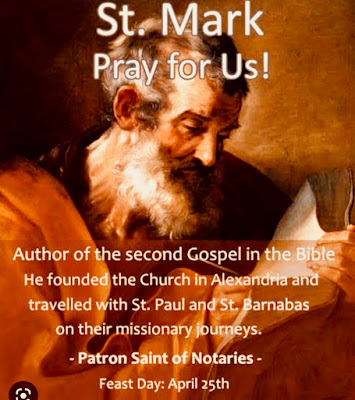St Mark the Evangelist
April 25, Feast of St Mark the Evangelist (5 AD - 25 April, 68 AD)
The Gospel of St Mark is the shortest of the four Gospels. It originated in Rome and is addressed to Romans since a lot of the Jewish traditions are explained in detail but unlike St Mathew’s Gospel, St Mark’s Gospel does not quote the Old Testament which had relevance to the unbelieving Jewish audiences of St Matthew. Another highlight is its fast-paced chronological presentation of the life of Christ - an almost breathless narrative pointing to the Gospel truth that Jesus Christ is our Saviour and Redeemer.
St Mark’s Gospel, sometimes referred to as the "Gospel of Peter," was written at the behest and under the direction of St Peter. This explains why incidents that St Peter witnessed are described in telling detail, for example, the encounter of Jesus with the possessed man at Capernaum (Mark 1:21-28).
The lion (or more correctly the winged lion) symbol is associated with St. Mark the Evangelist because according to ancient legend, while taking refuge from a storm in Venice, he was visited in a dream by an angel in the form of a winged lion. In the dream, the winged lion exclaimed in Latin “Pax tibi Marce Evangelista meus, hic requiescet corpus tuum” (“Peace to you, Mark, my Evangelist. Here will rest your body”). Mark died a martyr's death on 25 April 68 AD in Alexandria, Egypt, and in the 9th Century, two Venetian merchants offered the relics of St. Mark to the Doge of Venice. The Patriarchal Cathedral Basilica of Saint Mark (Basilica Cattedrale Patriarcale di San Marco) still stands today, built next to the Doge’s palace to house the holy relics. The Lion of Venice, (aka the winged Lion of St. Mark), standing atop a tall pedestal on Piazza San Marco, is the symbol of Venice!
John Mark, later known simply as Mark, was a Jew by birth. Some scholars believe that John was his Hebrew name while Mark was his Roman name. He was the son of Mary whose house, the Cenacle or “Upper room”, in Jerusalem was the meeting place of early Christians (Acts 12:12), where St. Peter sought refuge after having been freed from prison. He was baptized and instructed by St. Peter. He accompanied St. Paul and his own cousin St. Barnabas on their return journey to Antioch and on their first missionary journey (Acts 12:24—13:5a). But Mark was not prepared for the hardships of missionary work and therefore left them at Perge in Pamphylia to return home.
It is suggested that St Peter was married to a relative of Mark’s father. When Mark’s father died, he took care of Mark and considered him his son (1 Peter 5:13). So we can understand why when he was rejected by St Paul after the first missionary journey, St Barnabas and St Peter took him with them. Mark became the companion and secretary of St. Peter in Rome about the year 42 A.D. He wrote his Gospel about the year 50 A.D, shortly after the Gospel of St Matthew.
St Paul had Luke, the physician, accompany him on his missionary journey. Hence, St. Luke’s Gospel reflects the thoughts of Paul. Indeed, the Acts of the Apostles, which traces the missionary journeys of St Paul, was written by St Luke as a sequel to the Gospel. Time healed the strained relations between St Paul and Mark, and during the former's first Roman captivity Mark rendered St Paul valuable service (Col. 4:10; Philem. 24), and the Apostle learned to appreciate him. In his final days, St Paul wrote from prison with a note of consolation when he remarked, “Only Luke is with me. Get Mark and bring him with you, for he is useful in my ministry.” (2 Tim 4:11)
References:
1. Feast of St. Mark, Evangelist; Major Rogation Day - April 25, 2024. (2024, April 25). Catholic Culture. Retrieved April 25, 2024, from https://www.catholicculture.org/culture/liturgicalyear/calendar/day.cfm?date=2024-04-25&
2. Saint of the Day – 25 April – St Mark the Evangelist. (2023, April 24). AnaStpaul. Retrieved April 25, 2024, from https://anastpaul.com/2018/04/25/saint-of-the-day-25-april-st-mark-the-evangelist/
3. Lion of St. Mark Jetton. (n.d.). Historic Jamestowne. Retrieved April 25, 2024, from https://historicjamestowne.org/collections/artifacts/lion-st-mark




Comments
Post a Comment
Please keep conversations courteous and on-topic. Kindly don’t engage in trolling, flame-baiting, name-calling, insulting, stereotyping or gratuitous attacks. Thank you for being a good citizen.